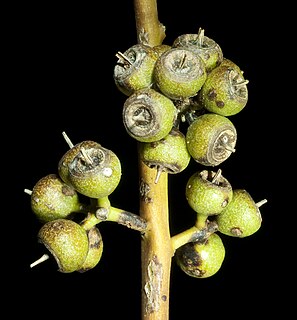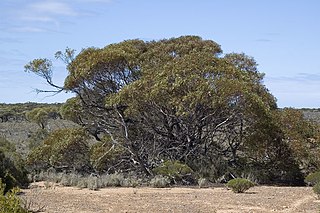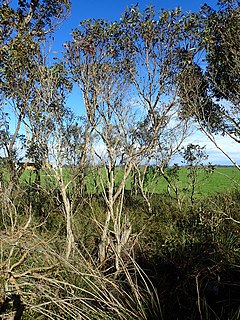
Eucalyptus conferruminata, commonly known as Bald Island marlock or bushy yate, is a small tree or mallee endemic to the south coast of Western Australia. It has smooth whitish and grey bark, elliptic to oblong or egg-shaped adult leaves, flower buds in fused in groups of between fifteen and twenty one, green to yellowish flowers and fruit forming a woody mass.
Eucalyptus arborella, commonly known as Twertup mallet, is a mallet or small tree that is endemic to a small area in the south-west of Western Australia. It has smooth greyish bark, narrow lance-shaped adult leaves, flower buds in groups of thirteen to twenty fused together, yellowish green flowers, and fruits fused together in a woody mass.

Eucalyptus calcicola, commonly known as the Boranup mallee, Harry Butler's mallee or Hamelin Bay mallee, is a mallee that is endemic to a small area in the south-west of Western Australia. It has smooth, pale greenish bark, lance-shaped to curved adult leaves, flower buds in groups of seven or nine, white flowers and ribbed, cup-shaped to hemispherical fruit.

Eucalyptus gittinsii, commonly known as northern sandplain mallee, is a species of mallee that is endemic to Western Australia. It has smooth greyish bark, sometimes with rough flaky bark near the base, lance-shaped to curved adult leaves, flower buds in groups of three, whitish flowers and cylindrical to barrel-shaped fruit.
Eucalyptus litorea, commonly known as saline mallee, is a species of mallee that is endemic to a small area on the southern coast of Western Australia. It has hard, rough grey bark on the trunk, smooth grey bark above, lance-shaped adult leaves, flower buds in groups of seven, white flowers and cylindrical or barrel-shaped fruit.

Eucalyptus petrensis, commonly known as limestone mallee, straggly mallee or koodjat, is a species of straggly mallee that is endemic to Western Australia. It has mostly smooth bark, lance-shaped adult leaves, flower buds in groups of between seven and thirteen, creamy white flowers and more or less spherical fruit.

Eucalyptus talyuberlup, commonly known as Stirling Range yate, is a species of small tree or a mallee that is endemic to a small area of the Great Southern region of Western Australia. It has smooth bark, glossy green, narrow lance-shaped adult leaves, flower buds in groups of seven to thirteen, yellowish green flowers and bell-shaped to cup-shaped fruit.
Eucalyptus vegrandis, commonly known as the Ongerup mallee, is a species of mallee that is endemic to the south-west of Western Australia. It has smooth bark, linear to lance-shaped adult leaves, flower buds in groups of seven, creamy white flowers and cup-shaped or conical fruit.

Eucalyptus yalatensis, commonly known as the Yalata mallee, is a species of mallee or a shrub that is endemic to southern Australia. It has rough, fibrous or flaky bark on the stems, smooth bark above, lance-shaped adult leaves, flower buds mostly in groups of nine, creamy white or yellowish flowers and hemispherical to shortened spherical fruit.

Eucalyptus extrica, commonly known as eastern tallerack, is a species of mallee that is endemic to Western Australia. It has smooth bark, lance-shaped adult leaves arranged in opposite pairs, flower buds in groups of three, whitish flowers and cylindrical to barrel-shaped fruit.

Eucalyptus alatissima is a mallee that is endemic to central parts of the Great Victoria Desert. It has rough bark on the lower part of its stems, smooth tan to cream-coloured bark on its upper parts, egg-shaped to lance-shaped leaves and buds in groups of three. The buds have a powdery covering and are prominently winged.
Eucalyptus sinuosa, commonly known as octopus mallee, is a species of mallee that is endemic to Western Australia. It has smooth bark, linear leaves, flower buds fused together in clusters of between eleven and twenty-five, greenish yellow flowers and fruit that are fused into a woody mass.

Eucalyptus adesmophloia is a mallee that is endemic to the south-west of Western Australia. Its fresh bark is grey, the leaves are a glossy dark green, the flowers are white and borne in large groups, and the fruits are conical to hemispherical.

Eucalyptus armillata, commonly known as red-flowered mallee, is a mallee that is endemic to the south-west of Western Australia. It has smooth bark, narrow lance-shaped adult leaves, flower buds hanging downwards in groups of three, usually red flowers and prominently ribbed fruit with a double flange around the rim.
Eucalyptus distuberosa is a species of mallet that is endemic to the south-west of Western Australia. It has smooth dark grey to tan-coloured or creamy white bark, glossy dark green, lance-shaped adult leaves, flower buds in groups of seven, white flowers and cup-shaped to conical fruit.
Eucalyptus ecostata, commonly known as coastal silver mallee, is a species of mallee that is endemic to the south coast of Western Australia. It has smooth greyish bark, lance-shaped to curved adult leaves, flower buds in groups of between eleven and fifteen, creamy white flowers and more or less hemispherical but flattened fruit.
Eucalyptus frenchiana is a species of mallet that is endemic to Western Australia. It has smooth bark, narrow lance-shaped, glossy green adult leaves, ribbed flower buds in groups of three, white flowers and ribbed, conical to cup-shaped fruit.
Eucalyptus notactites, commonly known as southern limestone mallee, is a species of mallee that is endemic to the southwest of Western Australia. It has smooth, greyish bark, lance-shaped adult leaves, flower buds in groups of between eleven and fifteen, creamy white flowers and hemispherical fruit.
Eucalyptus proxima, commonly known as nodding mallee or red-flowered mallee, is a species of mallee that is endemic to a small area in the south-west of Western Australia. It has smooth greyish bark, lance-shaped adult leaves, flower buds in groups of seven, red to pink, sometimes yellowish flowers and conical to slightly bell-shaped fruit.
Eucalyptus rowleyi is a species of mallee that is endemic to the Pilbara region of Western Australia. It has smooth grey bark, lance-shaped adult leaves, flower buds in groups of seven or nine, white flowers and cylindrical to urn-shaped fruit.










